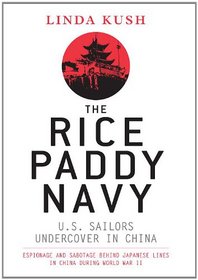During my life I have read hundreds of book on World War II. One special interest I have is on the the code wars and secret operations. Therefore, I was astonished when reading this book to realize I knew nothing about "The Rice Paddy Navy, " or its correct name of Sino-American Cooperative Organization (SACO).
This may be because one of its enemies was General Donovan, the head of the OSS during World War II. Despite the impressive achievements of SACO, the OSS, and later the CIA, may have deliberately "erased" this organization's history from World War II history.
If you're not interested in reading the book, you can learn more about it by searching Wikipedia for its official name. On that page, also click on the link to ""How naked World War II sailors ended up riding Mongolian ponies in the Gobi Desert to shoot bazookas at the Japanese." That page goes into far more detail than the Wikipedia page. Since I've read the book, I know that when the sailors attacked the Japanese they weren't naked that day.
One World War II movie I always liked was "Destination Gobi," staring Richard Widmark. I always thought this movie was a product of Hollywood's imagination, but it was based on a real unit of U.S. Navy personnel stationed in that area, the same guys who attacked the Japanese on horseback. You can read more about that movie by searching for it's Wikipedia page. You might enjoy reading how the movie may have inspired the creation of the "McHale's Navy" TV show.
Starting with just an idea, and having to scrounge for everything and fight a military bureaucracy for its supplies, SACO accomplished an amazing record. Its personnel, sailors and Marines, not only trained tens of thousands of Chinese soldiers, but also fought alongside them in raids on the Japanese, killing tens of thousands and wounding many more. SACO personnel lived with and under the same conditions as the Chinese and did so effectively. It's a must read for those interested in World War II in the Pacific theater.
This may be because one of its enemies was General Donovan, the head of the OSS during World War II. Despite the impressive achievements of SACO, the OSS, and later the CIA, may have deliberately "erased" this organization's history from World War II history.
If you're not interested in reading the book, you can learn more about it by searching Wikipedia for its official name. On that page, also click on the link to ""How naked World War II sailors ended up riding Mongolian ponies in the Gobi Desert to shoot bazookas at the Japanese." That page goes into far more detail than the Wikipedia page. Since I've read the book, I know that when the sailors attacked the Japanese they weren't naked that day.
One World War II movie I always liked was "Destination Gobi," staring Richard Widmark. I always thought this movie was a product of Hollywood's imagination, but it was based on a real unit of U.S. Navy personnel stationed in that area, the same guys who attacked the Japanese on horseback. You can read more about that movie by searching for it's Wikipedia page. You might enjoy reading how the movie may have inspired the creation of the "McHale's Navy" TV show.
Starting with just an idea, and having to scrounge for everything and fight a military bureaucracy for its supplies, SACO accomplished an amazing record. Its personnel, sailors and Marines, not only trained tens of thousands of Chinese soldiers, but also fought alongside them in raids on the Japanese, killing tens of thousands and wounding many more. SACO personnel lived with and under the same conditions as the Chinese and did so effectively. It's a must read for those interested in World War II in the Pacific theater.




![header=[] body=[Get a free book credit right now by joining the club and listing 5 books you have and are willing to share with other members!] Help icon](/images/question.gif?v=52444873)
